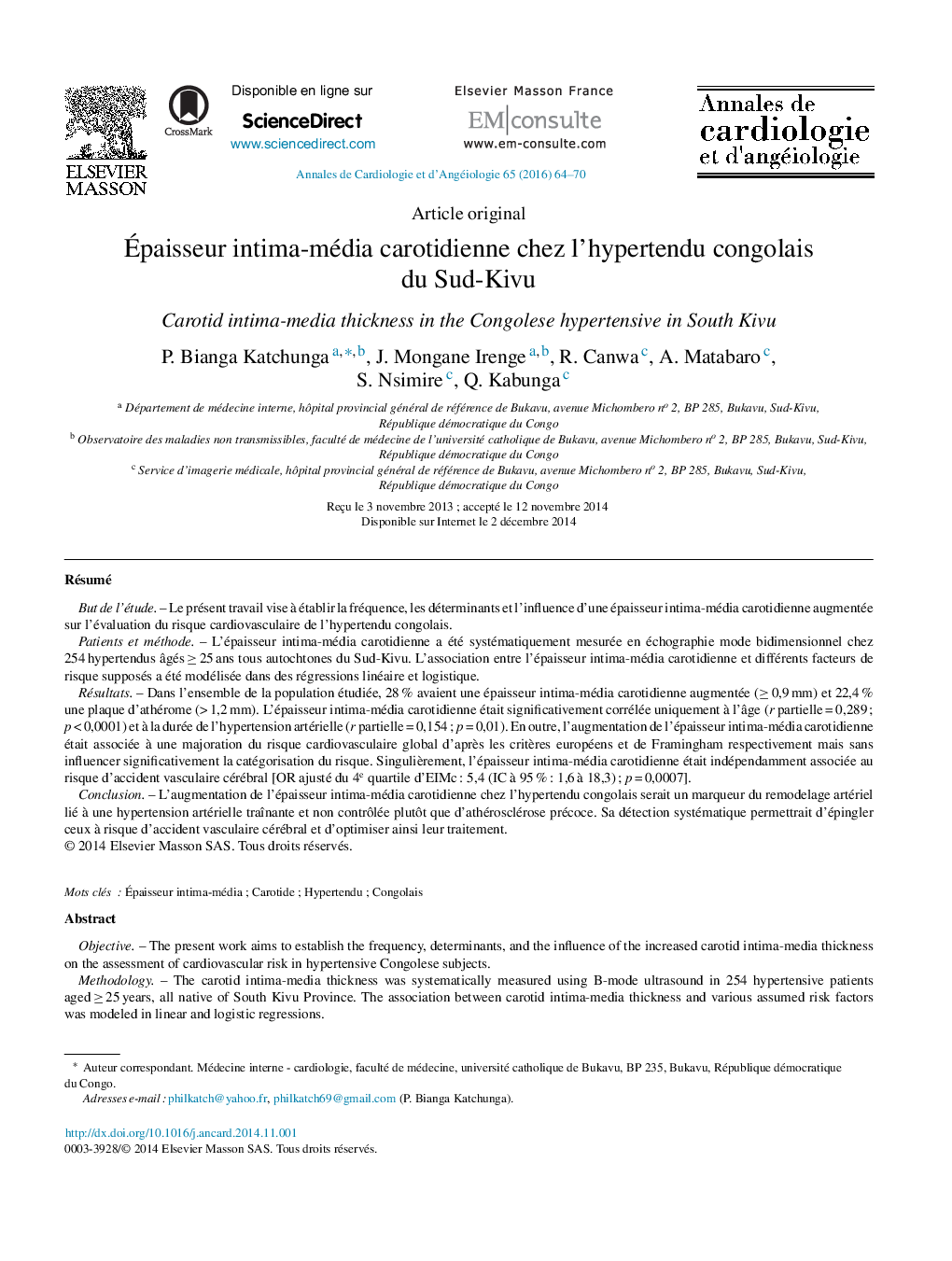| Article ID | Journal | Published Year | Pages | File Type |
|---|---|---|---|---|
| 2868535 | Annales de Cardiologie et d'Angéiologie | 2016 | 7 Pages |
RésuméBut de l’étudeLe présent travail vise à établir la fréquence, les déterminants et l’influence d’une épaisseur intima-média carotidienne augmentée sur l’évaluation du risque cardiovasculaire de l’hypertendu congolais.Patients et méthodeL’épaisseur intima-média carotidienne a été systématiquement mesurée en échographie mode bidimensionnel chez 254 hypertendus âgés ≥ 25 ans tous autochtones du Sud-Kivu. L’association entre l’épaisseur intima-média carotidienne et différents facteurs de risque supposés a été modélisée dans des régressions linéaire et logistique.RésultatsDans l’ensemble de la population étudiée, 28 % avaient une épaisseur intima-média carotidienne augmentée (≥ 0,9 mm) et 22,4 % une plaque d’athérome (> 1,2 mm). L’épaisseur intima-média carotidienne était significativement corrélée uniquement à l’âge (r partielle = 0,289 ; p < 0,0001) et à la durée de l’hypertension artérielle (r partielle = 0,154 ; p = 0,01). En outre, l’augmentation de l’épaisseur intima-média carotidienne était associée à une majoration du risque cardiovasculaire global d’après les critères européens et de Framingham respectivement mais sans influencer significativement la catégorisation du risque. Singulièrement, l’épaisseur intima-média carotidienne était indépendamment associée au risque d’accident vasculaire cérébral [OR ajusté du 4e quartile d’EIMc : 5,4 (IC à 95 % : 1,6 à 18,3) ; p = 0,0007].ConclusionL’augmentation de l’épaisseur intima-média carotidienne chez l’hypertendu congolais serait un marqueur du remodelage artériel lié à une hypertension artérielle traînante et non contrôlée plutôt que d’athérosclérose précoce. Sa détection systématique permettrait d’épingler ceux à risque d’accident vasculaire cérébral et d’optimiser ainsi leur traitement.
ObjectiveThe present work aims to establish the frequency, determinants, and the influence of the increased carotid intima-media thickness on the assessment of cardiovascular risk in hypertensive Congolese subjects.MethodologyThe carotid intima-media thickness was systematically measured using B-mode ultrasound in 254 hypertensive patients aged ≥ 25 years, all native of South Kivu Province. The association between carotid intima-media thickness and various assumed risk factors was modeled in linear and logistic regressions.ResultsIn the entire study population, 28% had an increased carotid intima-media thickness (≥ 0.9 mm) and 22.4% a plaque (> 1.2 mm). Carotid intima-media thickness was significantly correlated only with age (partial r = 0.289, P < 0.0001) and duration of hypertension (partial r = 0.154, P = 0.01). In addition, the increase in carotid intima-media thickness was associated with an increased global cardiovascular risk according to the European and Framingham criteria, respectively, and independently, the risk of stroke [fourth cIMT quartile adjusted OR = 5.4 (95% CI: 1.6 to 18.3), P = 0.0007]. However, carotid intima-media thickness did not significantly influence the cardiovascular risk categorization (P > 0.05).ConclusionThe increase in carotid intima-media thickness in hypertensive Congolese subjects would be a marker of arterial remodeling associated with a long history of uncontrolled hypertension rather than early atherosclerosis. Its systematic detection would pinpoint those at risk of stroke and optimize their treatment.
